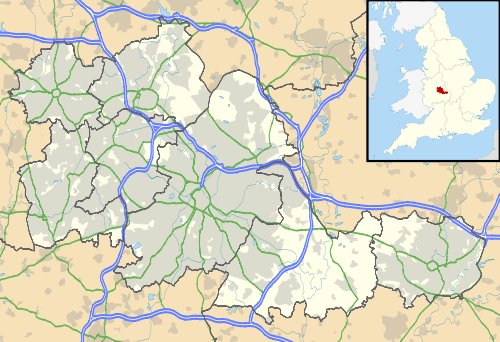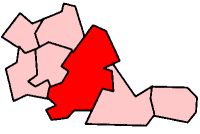Hay Mills
Coordinates: 52°27′58″N 1°48′58″W / 52.466°N 1.816°W
Hay Mills is an area in the east of Birmingham, England adjacent to Small Heath. Historically, it was in Worcestershire, part of the parish of Yardley out of which it was created in the 19th century. The area is bisected by the Coventry Road, now the main A45 from Birmingham to Coventry and consists of the area immediately either side of the road once the River Cole has been crossed heading eastwards out of Birmingham until the junction with the A4040 at Yardley Road. Hobmoor Road provides a northern boundary whilst the Birmingham and Warwick Junction Branch of the Grand Union Canal, running behind Ammington and Speedwell Roads, provides a boundary to the south.
History
Haye is the first recorded name dating to 1171 and Hayemill by 1495. In Old English, gehaeg means 'fenced/ hedged land'. Here would have been the farm of a medieval family who had enclosed some of the fertile land near the River Cole. The enclosed fields may have been surrounded by a substantial ditch perhaps as wide as two metres and over a metre in depth. There was a corresponding bank of similar dimensions. It is likely that the bank would have been topped with a fence while a live hedge grew. The hedge would have been planted with hawthorn, a quick growing tree whose name literally means 'hedge thorn'. It is likely that the enclosures would have been used for keeping livestock, probably cattle, close to the lush watermeadows along the river. Hugh de la Haye, his family name taken from the placename, is recorded in 1171.[1]
The district takes its full name from Hay Mill which stood on the River Cole near James Road/ Mill Road. The mill belonged to the occupants of Hay Hall and ground corn from at least 1495. Converted to blade grinding probably during the Civil War, this trade continued until about 1830 when James Horsfall, a wire drawer of Digbeth moved here. There was no settlement at Hay Mills in 1834, but by 1888 the south side of the Coventry Road was being built up from Heybarnes Road to Forest Road. He had the old buildings demolished and rebuilt some 100m north of the old site. Here a larger mill with a larger pool was built for wire drawing. Other industries included Iron founding, brick manufacture, cabinet manufacture, electrical switch making and the embryonic British motorcycle industry in Kings Road. By 1906 there was considerable urbanisation, although Hay Mills was still separated from Small Heath by the undeveloped Cole valley and becoming part of Birmingham in 1911.[2]
Industry

Webster Horsfall: James Horsfall, a wire drawer from Digbeth invented high tensile steel wire. He moved to Hay Mill (grid reference SP108849), a disused blade and sword factory at a water mill on the River Cole, rebuilding it as a steam-driven mill. The mill originally belonged to Hay Hall (SP108845) in Tyseley. In 1855, his company merged with Joseph Webster's of Penn Mill, Sutton Coldfield. He was a major manufacturer and exporter of the piano wire to Europe in 1824.
In 1853, Horsfall had patented a heat treatment process which strengthened the wire. This led to improved piano wire (giving a near monopoly), wire for making needles in Redditch, fishhooks, and umbrella frames. The firm made the armoured wire for first successful transatlantic telegraph cable in 1866, using 30,000 miles of wire (1,600 tons), made by 250 workers over 11 months. The strengthened wire also made possible the construction of aeroplanes and automobiles. The company today also makes springs.
Latch and Batchelor: Founded by Mr Arthur Latch, Mr Telford Clarence Batchelor and Mr Henry Herbert Horsfall to develop Mr Batchelor’s patent of Locked Coil Wire Rope and Flattened Strand, it was formed in 1884 on part of the Hay Mills site owned at that time by Webster and Horsfall Ltd. Due to its smooth outer layer Locked Coil became increasing popular with its use in aerial ropeways and its unexpected yet excellent non-spinning properties and high breaking-strength-to-weight ratio were recognized by the mining industry and adopted worldwide. Locked Coil development continued with the advent of the half-lock Colliery Guide ropes and more use being made of galvanized wires. The company was one of the first to come under direct Government control in both World Wars. In the 1914–18 war they were the sole manufacturer of shell fuse spring wire, for example, producing 80,260 miles, along with anti-submarine netting, mine, aircraft and balloon cables.
The works did not fare so well in the 1939–45 conflict, receiving several direct hits during air raids. The main crane in the rope mill still shudders halfway down the shop caused by slight track misalignment from this time. The virtual extinction of Britain’s core manufacturing industries and mining caused a re-focus our the entire manufacturing operation at Hay Mills in the 1980s, and as a result the company now concentrates on manufacturing a variety of specialist mining ropes for the export market as well as stocking, servicing and trading a wide range of high-quality ropes and attachments for numerous applications.
Governance
Nationally, Hay Mills is part of Birmingham, Yardley constituency[n 1] represented in the House of Commons of the UK Parliament since 2015 by Jess Phillips of the Labour Party.[n 2]
Hay Mills is included in the West Midlands electoral region of the European Parliament, the seven members elected in 2014 are; Philip Bradbourn OBE, (who died in December 2014) and Anthea McIntryre (Conservative), Neena Gill and Sion Simon (Labour) and Jim Carver, Bill Etheridge and Jill Seymour (UK Independence).
Transport
- The Grand Union Canal and the Leamington Spa to Birmingham railway line pass through the district. Tyseley and Small Heath are the closest railway stations situated approximately a 1 mile (1.6 km) from Hay Mills and served by London Midland to Birmingham, Dorridge and Leamington Spa and Chiltern Railways to Warwick, High Wycombe and London Marylebone.
- Motorway access is via junction 6 of the M42 beyond Birmingham Airport 5.4 miles (8.7 km) away with links to the M5, M6 and M40 motorways.
- The nearest airport is Birmingham International Airport situated 5.4 miles (8.7 km) to the East.
Education
- Redhill Junior and Infant School, Redhill Rd, Birmingham, West Midlands B25 8HQ. School web page
Religious sites
St Cyprians Church is situated in the Fordrough.
Notable buildings

Horsfall built houses and, in 1863, a school for his workers’ children. In 1873, he built a church, St Cyprian's, designed by Frank Barlow Osborn[3] and now grade II listed, over the mill race on the mill site. This developed into the village of Hay Mills.
Notable people
Kevin McNally Actor
Fred Starkey Amateur athlete and model for a sculpture of the Greek god Apollo by William Bloye, which stands in Coronation Gardens, Dudley.[4]
See also
- Penns Hall, original mill of Joseph Webster
- St. Cyprian's Church, Hay Mills
Notes and references
- Notes
- ↑ A borough constituency (for the purposes of election expenses and type of returning officer)
- ↑ As with all constituencies, the constituency elects one Member of Parliament (MP) by the first past the post system of election at least every five years.
- References
- ↑ http://billdargue.jimdo.com/placenames-gazetteer-a-to-y/places-h/hay-mills/
- ↑ http://billdargue.jimdo.com/placenames-gazetteer-a-to-y/places-h/hay-mills/
- ↑ English Heritage listed building status Accessed 13 January 2013
- ↑ Anon (2 April 2001). "Former city man tribute". Birmingham Evening Mail. – via HighBeam (subscription required)
- John Philip Lethbridge (2002-01-01). Victorian Birmingham. ISBN 978-0-9512227-8-2.
- Christopher Upton (1993-09-30). A history of Birmingham. Phillimore & Company. ISBN 0-85033-870-0.
- John Horsfall (December 1971). The Ironmasters of Penns. The Roundwood Press. ISBN 978-0-900093296.
- Webster and Horsfall
- BBC article on the mill and the transatlantic cable
- National Archives - Short history
- Origins of Hay Mill and Hay Hall
External links
- Historic England. "St Cyprian's Church - Grade II listed (217056)". Images of England.
- Historic England. "Hay Hall - Grade II listed (217524)". Images of England.


